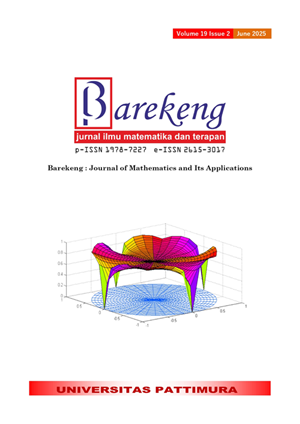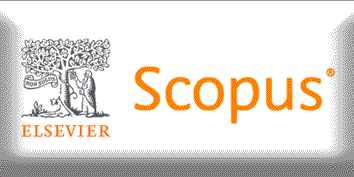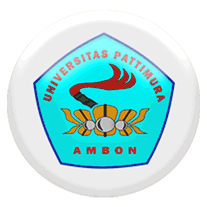ESTIMATION OF VALUE AT RISK FOR GENERAL INSURANCE COMPANY STOCKS USING THE GARCH MODEL
Abstract
Investment plays a crucial role in supporting economic development by allocating funds to generate future profits. Among various investment options, stock investment is widely popular. However, investors face the challenge of developing strategies to maximize returns while minimizing risks. Effective investment requires understanding the potential maximum risk of loss, known as Value at Risk (VaR). This research focuses on estimating VaR for four top general insurance companies in Indonesia: PT Lippo General Insurance Tbk (LPGI), PT Asuransi Tugu Pratama Indonesia Tbk (TUGU), PT Victoria Insurance Tbk (VINS), and PT Asuransi Dayin Mitra Tbk (ASDM). These companies were selected due to their leading positions in the industry. The Generalized Autoregressive Conditional Heteroscedasticity (GARCH) model, an extension of the ARIMA method designed to handle volatility clustering, is utilized for VaR estimation. Results at confidence levels of 90%, 95%, and 99% reveal that VINS carries the highest risk, with a maximum VaR of IDR 2,848,710 at 99% confidence, while LPGI shows the lowest risk, with a maximum VaR of IDR 22,677. For TUGU, the maximum possible loss is IDR 517,589, and for ASDM, it is IDR 1,532,267. Backtesting confirms the reliability of the models, with some accepted at specific significance levels. Based on this analysis, the results can help investors make investment decisions that minimize potential losses, specifically in the four stocks analyzed.
Downloads
References
W. Widiyatari, E. Sulistianingsih, W. Andani, “ANALISIS VALUE AT RISK PORTOFOLIO SAHAM LQ45 DENGAN METODE SIMULASI MONTE CARLO CONTROL VARIATES,” Jurnal Matematika Murni Dan Terapan, vol. 17, p. 91–100, 2023.
W. Palisungan, “PENGARUH RISIKO INVESTASI TERHADAP RETURN SAHAM PADA PERUSAHAAN OTOMOTIF YANG TERDAFTAR DI BURSA EFEK INDONESIA,” 2021.
Tarno, D. A. I. Maruddani, R. Rahmawati, A. Hoyyi, Trimono, & Munawar, “ARMA-GARCH MODEL FOR VALUE-AT-RISK (VAR) PREDICTION ON STOCKS OF PT ASTRA AGRO LESTARI TBK,” Journal of Mathematical and Computational Science, vol. 11, no. 2, p. 2136–2152, 2021.
S.I. Gunawan, “VALUE AT RISK AND EXPECTED SHORTFALL CALCULATION OF DIGITAL BANK STOCKS PORTFOLIO IN INDONESIA,” President University, 2023.
R. Ramayanti, D. Devianto, & D. Alhusna, “PEMODELAN ARIMA-GARCH UNTUK VOLATILIAS DAN VALUE AT RISK PADA SAHAM PT GUDANG GARAM TBK,” Jurnal Ilmiah Pendidikan Matematika, Matematika Dan Statistika, vol. 4, no. 2, 2023.
N. K. Juliarini, I. W. Sumarjaya, & K. Sari, “PERAMALAN VOLATILITAS DAN ESTIMASI VALUE AT RISK (VAR) SAHAM BLUE CHIP PADA SEKTOR PERBANKAN,” E-Jurnal Matematika, vol. 10, no. 4, p. 198, 2021.
R. A. Hidayana, H. Napitupulu, & Sukono, “AN INVESTMENT DECISION-MAKING MODEL TO PREDICT THE RISK AND RETURN IN STOCK MARKET: AN APPLICATION OF ARIMA-GJR-GARCH,” Decision Science Letters, vol. 11, no. 3, p. 235–246, 2022.
W. Apriani, & A. W. Bustan, “VALUE AT RISK PREDICTION FOR THE GJR-GARCH AGGREGATION MODEL,” Pattimura International Journal of Mathematics, vol. 1, no. 1, 2022.
F.A. Kanal, T. Manurung, & J.D Prang, “APPLICATION OF GARCH (GENERALIZED AUTOREGRESSIVE CONDITIONAL HETEROSCEDASTICITY) MODEL IN CALCULATING BETA VALUE OF STOCK INDEX PEFINDO25,” Jurnal Ilmiah Sains, vol. 18, 2018.
J.D. Cryer, & K. S. Chan, TIME SERIES ANALYSIS: WITH APPLICATIONS IN R (SECOND EDITION), SPRINGER SCIENCE & BUSINESS MEDIA, 2008.
R. Ramayanti, D. Devianto, & D. Alhusna, “PEMODELAN ARIMA-GARCH UNTUK VOLATILIAS DAN VALUE AT RISK PADA SAHAM PT GUDANG GARAM TBK,” Jurnal Ilmiah Pendidikan Matematika, Matematika Dan Statistika, vol. 4, no. 2, 2023.
A. Hidayana, H. Napitupulu, & J. Saputra, “DETERMINATION OF RISK VALUE USING THE ARMA-GJR-GARCH MODEL ON BCA STOCKS AND BNI STOCKS,” vol. 2, no. 3, pp. 62-66, 2021.
Q. Chen, & R. Chen, “METHOD OF VALUE-AT-RISK AND EMPIRICAL RESEARCH FOR SHANGHAI STOCK MARKET,” Procedia Computer Science, vol. 17, p. 671–677, 2013.
M. Y. T. Irsan, E. Priscilla, & S. Siswanto, “COMPARISON OF VARIANCE COVARIANCE AND HISTORICAL SIMULATION METHODS TO CALCULATE VALUE AT RISK ON BANKING STOCK PORTFOLIO,” Jurnal Matematika, Statistika Dan Komputasi, vol. 19, no. 1, pp. 241-250, 2022.
P. Jorion, VALUE AT RISK: THE NEW BENCHMARK FOR MANAGING FINANCIAL RISK (3rd ed.), McGraw-Hill, 2007.
P. E. Astuti, & T. Gunarsih, “VALUE-AT-RISK ANALYSIS IN RISK MEASUREMENT AND FORMATION OF OPTIMAL PORTFOLIO IN BANKING SHARE,” JBTI: Jurnal Bisnis: Teori Dan Implementasi, vol. 12, no. 2, pp. 103-114, 2021.
Copyright (c) 2025 Edwin Setiawan Nugraha, Agna Olivia, Fauziah Nur Fahirah Sudding, Karunia Eka Lestari

This work is licensed under a Creative Commons Attribution-ShareAlike 4.0 International License.
Authors who publish with this Journal agree to the following terms:
- Author retain copyright and grant the journal right of first publication with the work simultaneously licensed under a creative commons attribution license that allow others to share the work within an acknowledgement of the work’s authorship and initial publication of this journal.
- Authors are able to enter into separate, additional contractual arrangement for the non-exclusive distribution of the journal’s published version of the work (e.g. acknowledgement of its initial publication in this journal).
- Authors are permitted and encouraged to post their work online (e.g. in institutional repositories or on their websites) prior to and during the submission process, as it can lead to productive exchanges, as well as earlier and greater citation of published works.






1.gif)



